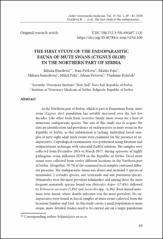| dc.contributor.author | Đurđević, Biljana | |
| dc.contributor.author | Pavlović, Ivan | |
| dc.contributor.author | Pajić, Marko | |
| dc.contributor.author | Samojlović, Milena | |
| dc.contributor.author | Pelić, Miloš | |
| dc.contributor.author | Petrović, Jelena | |
| dc.contributor.author | Polaček, Vladimir | |
| dc.date.accessioned | 2020-08-26T11:30:27Z | |
| dc.date.available | 2020-08-26T11:30:27Z | |
| dc.date.issued | 2020 | |
| dc.identifier.issn | 1820-9955 | |
| dc.identifier.uri | https://repo.niv.ns.ac.rs/xmlui/handle/123456789/293 | |
| dc.description.abstract | In the Northern part of Serbia, which is part of Pannonian Basin, mute
swan (Cygnus olor) population has notably increased over the last few
decades. Like other birds from Anatidae family, mute swans are a host of
numerous endoparasite species. The aim of this study was to acquire the
data on identification and prevalence of endoparasites in mute swans in the
Republic of Serbia, as that information is lacking. Individual faecal samples
of sixty-eight adult mute swans were examined for the presence of endoparasites.
Coprological examination was performed using flotation and
sedimentation technique with saturated ZnSO4 solution. The samples were
collected from December 2016 to March 2017, during epizootic of highly
pathogenic avian influenza H5N8 in the Republic of Serbia. Dead mute
swans were collected from twelve different locations in the Northern part
of Serbia. Altogether, 39.7% of the examined fecal samples contained different
parasites. The endoparasitic fauna was divers and included 3 species of
nematodes, 2 cestodes species, one trematode and one protozoan species.
Nematodes were the most prevalent helminthes and among these the most
frequent nematode species found was Heterakis dispar (17.6%), followed
by Echinuria uncinata (5,8%) and Ascaridia spp. (4,4%). Four mixed infections
were found, where double infection was the most prevalent. No endoparasites
were found in faecal samples of mute swans collected from the
locations Sombor and Titel. As this study covers a small population of mute
swans, more detailed studies need to be carried out on a larger population in order to gain an insight into the diversity and prevalence of endoparasites in the Republic of Serbia. | en_US |
| dc.description.sponsorship | This study was supported by the Ministry of Education, Science and Technological
Development of the Republic of Serbia, Projects number TR 31011,
TR 31084 and TR31071. | en_US |
| dc.language.iso | en | en_US |
| dc.publisher | Naučni institut za veterinarstvo "Novi Sad" | en_US |
| dc.source | Arhiv veterinarske medicine / Archives of veterinary medicine | sr |
| dc.subject | coprological examination | en_US |
| dc.subject | endoparasites | en_US |
| dc.subject | mute swans | en_US |
| dc.subject | nematodes | en_US |
| dc.title | THE FIRST STUDY OF THE ENDOPARASITIC FAUNA OF MUTE SWANS (CYGNUS OLOR) IN THE NORTHERN PART OF SERBIA | en_US |
| dc.type | Article | en_US |
| dc.identifier.doi | 10.46784/e-avm.v13i1.100 | |

